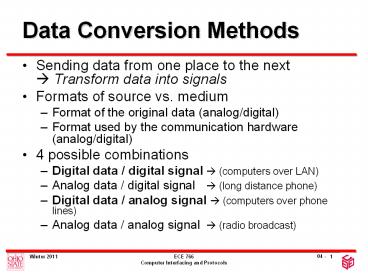ECE 766 PowerPoint PPT Presentation
1 / 21
Title: ECE 766
1
Data Conversion Methods
- Sending data from one place to the next?
Transform data into signals - Formats of source vs. medium
- Format of the original data (analog/digital)
- Format used by the communication hardware
(analog/digital) - 4 possible combinations
- Digital data / digital signal ? (computers over
LAN) - Analog data / digital signal ? (long distance
phone) - Digital data / analog signal ? (computers over
phone lines) - Analog data / analog signal ? (radio broadcast)
2
Data Encoding / Modulation
- Baseband
- Digitally Encoded
- Resources shared by Time Division Multiplexing
- Broadband
- Analog Modulation
- Resources shared by Frequency Division
Multiplexing
Should I have called the vertical axis bandwidth?
3
Terminology
- Data rate (bps)
- Baud rate, modulation rate (signal
elements/sec) - Mark (1) and space (0) conditions(from
telegraphy) - Connection types
- Simplex One way
- Half Duplex Two way, but only one way at a time
- (Full) Duplex Two way simultaneously
4
Criteria for a Good Encoding Scheme
- Signal Spectrum
- Minimize high frequency components
- No DC components
- Synch capability (find bit positions)
- Signal error detection capability
- Signal interference and noise immunity
- Cost and complexity
5
Absolute vs. Differential Encoding / Modulation
Schemes
- Absolute
- Each signal corresponds to a predetermined
information unit - The meaning of a signal sequence is fixed, not
relative. - Differential
- Information is encoded by difference between
current and previous signal element - The meaning of a signal sequence is relative, not
absolute.
6
Digital Encoding Schemes
- Digital information is converted to a sequence of
voltage pulses that propagate over the link - Three subcategories by voltage use
- Unipolar (Zero and Positive)
- Polar (Negative and Positive)
- Bipolar (Negative, Zero, and Positive)
7
Unipolar Encoding
- Uses zero and positive voltage pulses to encode
binary data - Not really encoded at all!
8
Polar Encoding
- Polar encoding uses a positive and a negative
voltage level to represent bits? Solves the DC
component problem(if balanced) - Categories
- Nonreturn to Zero (NRZ)
- NRZ-L (LLevel)
- NRZ-I (IInverted)
- Return to Zero (RZ)(as shown in book)
- Biphase
- Manchester
- Differential Manchester
9
Nonreturn to Zero (NRZ)
- The voltage level is constant during a bit
interval, i.e., no returns to zero - Absolute and differential versions
- Absolute NRZ NRZ-L (LLevel)(like ntl)
- 0 Positive voltage
- 1 Negative voltage
10
Nonreturn to Zero (NRZ)
- Differential NRZ NRZ-I (IInverted)
- A bit is represented by the transition of the
voltage level, not the voltage level itself! - 0 No inversion at beginning of bit interval
- 1 Inversion at beginning of bit interval
11
Nonreturn to Zero (NRZ)
- Evaluation
- No DC component
- Simple
- Few high frequency components
- Synchronization
- No synchronization at large (consider a string
of the same bit) - NRZ-I provides synchronization for every 1
encountered ? can handle strings of 1s(superior
to NRZ-L)
12
Return to Zero (RZ)(bipolar form)
- Targets to solve the synchronization problem
- A scheme that handles both strings of both 1s and
0s - Voltage level change for every bit value ? three
levels ,-, 0 - 0 Transition from negative to zero
- 1 Transition from positive to zero
13
Return to Zero (RZ)
- Variations used also for magnetic recording (no
synchronization capability) - Evaluation
- Solves synchronization problem
- Two signal changes / bit? More transitions ?
Occupies more bandwidth
14
Biphase
- Signal changes in the middle of the bit interval,
but does not return to zero - Signal change ? bit representation ?
synchronization - Manchester
- 0 Transition from positive to negative
- 1 Transition from negative to positive
15
Biphase
- Differential Manchester
- 0 Transition at the beginning of bit period
- 1 No transition at the beginning of bit period
- Evaluation
- Not as simple
- Higher frequency components (as RZ)
- Synchronization capability
- No DC component
16
Bipolar
- Like in RZ, three voltage levels are used
- Zero voltage level used for binary 0
- Categories
- Alternate Mark Inversion (AMI)
- Bipolar 8-Zero Substitution (B8ZS) ? North
America - High Density Bipolar 3 (HDB3)? Europe and Japan
17
Alternate Mark Inversion (AMI)
- Uses three voltage levels
- 0 Zero volts
- 1 Non-zero voltage, opposite in polarity to
the last logical 1 - Evaluation
- No DC component
- Synchronized only for 1s, not 0s
- Error detection
18
Bipolar 8-Zero Substitution (B8ZS)
- Adds synchronization for long strings of 0s
- North American system
- Same working principle as AMI except for eight
consecutive 0s - Evaluation
- Adds synchronization without changing the DC
balance - Error detection possible
10000000001 ? 000-0-01 in general
00000000?000V(-V)0(-V)V
19
High Density Bipolar 3 (HDB3)
- Goal like B8ZS to improve Sync of AMI
- Just like AMI except 4 0s are replaced by code
- For 0000 use 000V or B00V
- Where B and V are or
- And V is AMI violation, B is Balance Bit
- Use 000V if ODD number of and pulses so far
- Use B00V if EVEN, and B is opposite last pulse
20
High Density Bipolar 3 (HDB3)
- Same goal as B8ZS
- Based on AMI
- Replaces every four consecutive 0s based on
- Number of pulses since last substitution
- Polarity of last logical 1
Last 1 polarity of 1s -
ODD(revised 2011) 0000?000 0000?000-
Even(revised 2011) 0000?-00- 0000?00
21
High Density Bipolar 3 (HDB3)
- Example (revised 1-6-11)
- Number of 1s since last substitution is even,
last 1 negative (before this string) - Encode 100000000001
0
0
0
0
0
0
0
0
0
0
1
1
Amplitude
Time

